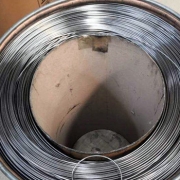How to weld alloy 20 steel?
Alloy20(UNS N08020), mainly composed of 35Ni-35Fe-20Cr-Nb, is Austenitic Fe-Ni base corrosion resistant alloy, which has excellent resistance to stress corrosion cracking and local corrosion, and good resistance to oxidation and moderate reducing corrosion. The alloy has good corrosion resistance in many chemical media, including aggressive strong inorganic acid solution, chlorine and various mediums containing chloride, formic acid and acetic acid, acid anhydride, dry chlorine gas, seawater and brine, etc., is an ideal conveying material for this medium, has been widely used in flue gas scrubber, hydrometallurgy and device in the sulfuric acid industry. Alloy20 steel tube, steel plate and steel bar (N08020) are specified in these standards: ASME SB462, SB463, SB464, SB468, SB473, SB729.
Alloy 20 Chemical Composition
| C | Mn | Si | P | S | Ni | Cr | Mo | Cu | Nb |
| ≤0.07 | ≤2.00 | ≤1.00 | ≤0.045 | ≤0.035 | 32.00-38.00 | 19.00-21.00 | 2.00-3.00 | 3.00-4.00 | 8*C-1.00 |
Alloy 20 Mechanical Property
| Tensile strength, Mpa | Yield strength, Mpa | Elongation, % |
| ≥551 | ≥241 | ≥30 |
Welding materials for alloy 20
| Stick Electrode | AWS A5.4 E320-16/ AWS A5.4 E320LR-16 |
| MIG wires | AWS A5.9 ER320LR |
| Argon arc welding | AWS A5.9ER320LR |
Alloy 20 Weldability
Similar to most Austenitic stainless steels, Alloy20 is prone to welding thermal cracks, intergranular corrosion and stress corrosion cracks during welding. At the same time, due to its high nickel content, liquid nickel fluidity is poor, welding is easy to produce unfusion, incomplete penetration and other defects, welding process should pay attention to the following tips:
1. Prevent heat cracking.
The welder should strictly control of sulfur, phosphorus, carbon and other harmful impurities in the welding, improve the weld crystal form; The multi-layer multi-pass welding with small current and short arc without a swing or small swing is adopted to strictly control the heat input, reduce the stiffness and constraint of the joint, and reduce the shrinkage stress in the crystallization process.
2. Prevent intergranular corrosion.
Using the welding material with low carbon content (<0.03%), containing stabilizing elements such as Nb or Ti. During welding, try to reduce overheating, minimize welding heat input, avoid cross weld and increase the cooling rate after welding, and strictly control the carburizing of weld area during welding.
3. Prevent stress corrosion.
Stress corrosion of weld metals can be alleviated or prevented by a reasonable welding sequence, minimizing joint constraint and stress-free pairs of pipes.
4. Other tips
- Remove moisture, dust, grease, paint, etc. on the surface of the weldment before welding, especially the impurities containing sulfur and lead;
- Direct contact between the base metal and welding material and carbon steel is strictly prohibited. Special stainless steel wire brush and grinding pieces are used.
- Before welding, both sides of the groove shall be cleaned within the range of 50mm, and the groove and welding wire shall be cleaned with acetone;
- The joints of each layer of weld pass shall be staggered, and the arc pit shall be filled at the end of the arc, and the arc pit defects shall be polished;
- The next welding can be carried out only when the temperature between the control channels is not greater than 100℃.

